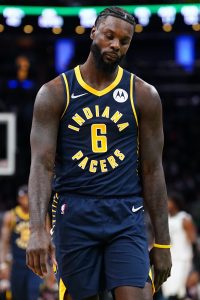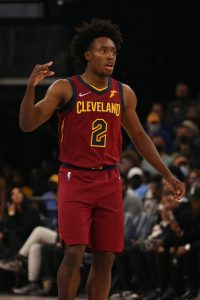It has been a record-setting season for the 10-day contract, which got more use than ever this winter as teams missing players due to COVID-19 scrambled to add multiple replacements at a time using the league’s newly-updated hardship provision.
By our count, an unprecedented 118 players have signed at least a single 10-day deal this season, and many of those players received more than one. Because hardship deals didn’t count toward the usual limit of two 10-day contracts per season with a single team, a handful of players even inked three or four 10-day pacts with the same team.
While no players were able to match or exceed the NBA’s rookie minimum salary on 10-day deals alone, a handful of players signed so many 10-day contracts that they earned a salary comparable to a two-way player.
[RELATED: Salaries For 10-Day Contracts In 2021/22]
With the help of our 10-day contract tracker, here’s a look at some of the players that have spent the most time this season on 10-day deals:
Chris Silva
- Total 10-day contracts: 5
- Days spent on 10-day contracts: 50
- Teams: Heat (x4), Timberwolves
- Total earnings on 10-day contracts: $479,650
One of two players who has signed four 10-day contracts with the same team this season, Silva might not be done yet — all four of his 10-day deals with the Heat were completed using the hardship provision, which means he could still sign one or two more standard 10-days with the team before the end of the season. Miami has an open roster spot, so it’s not out of the question.
Even if he doesn’t sign another 10-day contract this season, Silva’s earnings have already exceeded the base salary for a player on a two-way deal ($462,629).
 Lance Stephenson
Lance Stephenson
- Total 10-day contracts: 5
- Days spent on 10-day contracts: 43
- Teams: Pacers (x4), Hawks
- Total earnings on 10-day contracts: $690,095
One of Stephenson’s 10-day hardship deals with the Pacers was terminated after just three days so that he could sign a standard 10-day contract in order to remain on the active roster. As a result, he didn’t spend quite as many days as Silva as a 10-day player this season.
Still, Stephenson is one of just two players to have signed five 10-day contracts this year, and no player has earned more money via 10-day deals than he has this season. Stephenson also parlayed those four short-term commitments from Indiana into a rest-of-season deal.
Stanley Johnson
- Total 10-day contracts: 4
- Days spent on 10-day contracts: 40
- Teams: Lakers (x3), Bulls
- Total earnings on 10-day contracts: $480,332
Danuel House
- Total 10-day contracts: 4
- Days spent on 10-day contracts: 40
- Teams: Jazz (x3), Knicks
- Total earnings on 10-day contracts: $445,828
Wenyen Gabriel
- Total 10-day contracts: 4
- Days spent on 10-day contracts: 40
- Teams: Clippers (x2), Nets, Pelicans
- Total earnings on 10-day contracts: $383,720
There are five NBA players who have signed at least four 10-day contracts so far this season, with Johnson, House, and Gabriel joining Silva and Stephenson.
Johnson and House took very similar paths. Both players signed a single hardship 10-day contract with one team in December (the Bulls for Johnson and the Knicks for House), but didn’t get a chance to make a real impression for that team — Johnson was almost immediately placed in the COVID-19 protocols himself, while House logged just three total minutes for New York. Both players subsequently caught on with new clubs, signing a hardship 10-day contract and then a pair of standard 10-days before finalizing a full-season agreement.
Gabriel, meanwhile, has bounced around the NBA a little more this season, signing a total of four 10-day hardship deals with three separate teams. He didn’t earn a rest-of-season commitment from any of them, but eventually landed with the Lakers on a two-way contract.
Players who have signed three 10-day contracts this season:
- Zylan Cheatham, Heat/Jazz/Pelicans
- Marquese Chriss, Mavericks (x3) *
 DeMarcus Cousins, Nuggets (x3) *
DeMarcus Cousins, Nuggets (x3) *- Mamadi Diakite, Thunder (x3) *
- James Ennis, Nets/Clippers/Nuggets
- Tim Frazier, Magic (x2)/Cavaliers ^
- Langston Galloway, Nets (x2)/Bucks
- Shaquille Harrison, Nets (x2)/Grizzlies
- Haywood Highsmith, Heat (x3) #
- Justin Jackson, Suns (x2)/Celtics *
- Greg Monroe, Timberwolves/Wizards/Bucks
- Xavier Moon, Clippers (x3)
- Davon Reed, Nuggets (x3)
- Cassius Stanley, Pistons (x3)
- Isaiah Thomas, Lakers/Mavericks/Hornets ^
- D.J. Wilson, Raptors (x3) ^
* Chriss, Cousins, Diakite, and Jackson each had one of their 10-day contracts terminated early, so they’ve technically spent fewer than 30 days on 10-day deals this season.
^ The third 10-day contracts for Frazier, Thomas, and Wilson are still active.
# Highsmith’s third 10-day contract is still active. Additionally, his second deal was technically an 11-day contract since it ran through the All-Star break and needed to cover a minimum of three games.
 A top-14 pick who does not meet the starter criteria will receive a qualifying offer equal to the amount the 15th overall pick would receive if he signed for 120% of the rookie scale.
A top-14 pick who does not meet the starter criteria will receive a qualifying offer equal to the amount the 15th overall pick would receive if he signed for 120% of the rookie scale.